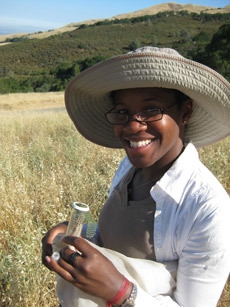- Author: Kathy Keatley Garvey

Grettenberger's project, "Assessing a Biocontrol System for the Management of Tadpole Shrimp in Rice," is one of 10 research grants sharing $3.75 million meant to explore integrated pest management (IPM) tools for urban, non-agricultural and agricultural pest management, according to DPR Director Julie Henderson.
The grant program, funded by the state budget, represents a 617 percent increase from the previous year's funding. In the last decade, DPR has awarded $9,702,819 in research grants.
The grant projects "are critical to developing and expanding innovative practices and biological, non-chemical and physical tools to manage pests in agriculture, urban and other non-agricultural communities,” said Henderson. “The research will support the state's work to accelerate a systemwide transition to safer, more sustainable pest management and better protect human health and the environment.”
"Tadpole shrimp usefully eat some early season weeds but can cause damage to rice later in their life cycle," Grettenberger noted. "To preserve their role in controlling weeds but diminish the shrimp's later impact on the rice harvest, predator mosquito fish will be introduced mid-season to control the shrimp's population when necessary."
The 10 projects comprise two areas of research:
- Research projects funded for urban and agriculture pest management
- Research projects funded for urban and nonagricultural pest management
Grettenberger, who joined the Department of Entomology and Nematology faculty in January 2019, received his bachelor of science degree in biology, with an ecology, evolution and organismal emphasis in 2009 from Western Washington University, Bellingham, Wash., and his doctorate in entomology in 2015 from Pennsylvania State University, State College, Pa. He served as a postdoctoral researcher in the Godfrey lab and later, in the Frank Zalom lab.
His fields of expertise include field and vegetable crops; integrated pest management; applied insect ecology, and biological control of pests.
The California Department of Pesticide Regulation aims to protect human health and the environment "by fostering safer and sustainable pest management practices and operating a robust regulatory system to evaluate and register pesticides and monitor and regulate their sale and use across the state." (See more information about DPR.)
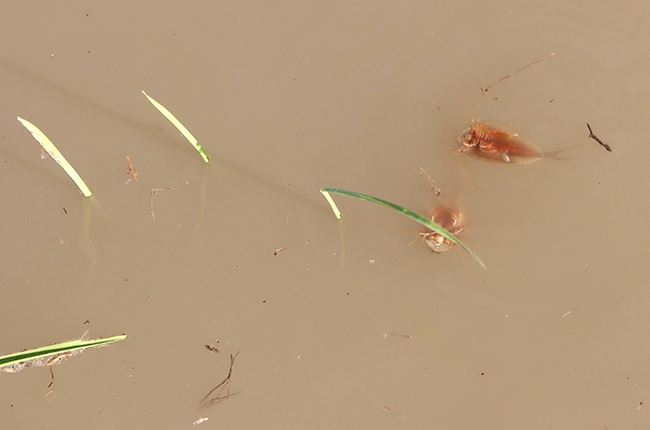

- Author: Kathy Keatley Garvey
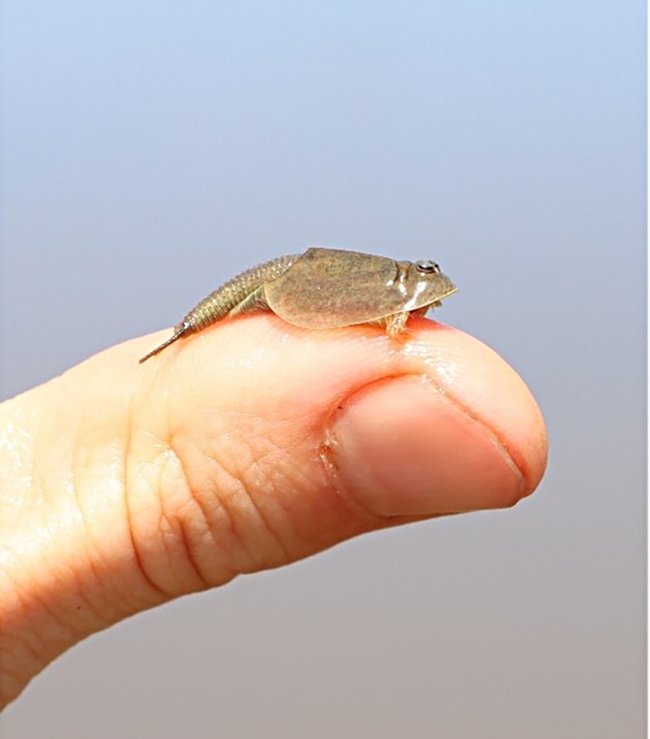
Agricultural entomologist and Cooperative Extension specialist Ian Grettenberger of the UC Davis Department of Entomology and Nematology and his colleagues propose alternative management.
Grettenberger's poster, “Past Pyrethroids: Alternative Management Approaches for Tadpole Shrimp in Rice,” presented at Entomological Society of America meeting (Oct. 31-Nov. 3) in Denver, offers non-pesticide alternatives, including the use of mosquitofish.
Collaborative research with UCCE Butte County director and Rice Farming Systems Advisor Luis Espino and UC Davis staff research associate Kevin Goding, indicates that mosquitofish proved able to suppress shrimp populations.
“Tadpole shrimp (Triops longicaudatus) are an early-season pest in California rice,” Grettenberger explained in his abstract. “Soon after flooding, eggs hatch and growing shrimp are soon large enough to damage germinating rice seedlings. Currently, pyrethroid insecticides are heavily relied upon for management, as they are in many cropping systems, because of their efficacy and low cost. However, contamination of surface waters is a concern, as is insecticide resistance.”
"We evaluated alternative management strategies that could be used to manage tadpole shrimp,” he wrote. “We tested a number of materials using small metal ring plots and natural shrimp populations. This included several timings of applications to mimic an early, more proactive application along with a later, rescue application, as well as reduced rates of a number of insecticides.”

Deep Look Video. Tadpole shrimp recently made the national news in two ways, Grettenberger said. First, they made news with the sudden appearance of tadpole shrimp following monsoon rains this summer in an ancient ceremonial ball court at the Wupatki National Monument in northern Arizona (https://www.livescience.com/dinosaur-shrimp-emerge-arizona). In October, KQED's Deep Look released a new video, “Tadpole Shrimp Are Coming For Your Rice," the work of lead producer and cinematographer Josh Cassidy and other members of the Deep Look crew. (See https://youtu.be/T2xnXaX7r3g.) Grettenberger assisted with the project, providing tadpole shrimp and taking some of the video clips used in the five-minute video.
“Much of his shooting was in my garage,” the UC Davis entomologist said, “so I get to see just how much effort and care goes into producing these videos. They end up pretty short, but that doesn't mean it is simple to get all the pieces together.”
“This tadpole shrimp is coming for your rice,” the narrator said. “Hungry hordes of them find their way into the ice fields of California's Central Valley and go to town munching on the young seedlings. But where did they come from, with the ocean so far away? A couple of weeks ago, this was just a dry dusty field. Turns out they were here all along.”
Deep Look referred to them as “time travelers,” as the eggs of shrimp tadpoles can be viable for decades and hatch when the rice growers flood their fields. "At the very least, they have survived as eggs since last season," Grettenberger noted.
The pests are neither tadpoles or shrimp but are fresh-water crustaceans descended from the ocean. “They look like tiny horseshoe crabs,” Grettenberger told Deep Look. “It's obvious when rice fields have lots of tadpole shrimp in them, because they stir up the mud making the water look a bit like chocolate milk. There will also be shrimp zooming around, many upside down at the surface, popping up for a few seconds before disappearing back into the murkiness."
Adult tadpole shrimp cannot survive when the soil dries out. But Grettenberger said their eggs have a rugged outer layer called a “chorion” that protects the eggs from desiccation.
“They've been living this way for hundreds of millions of years-- since before the dinosaurs-- waiting out droughts, changing climates, even global catastrophes,” KQED relates in the video. “In a world where the future is unpredictable, tadpole shrimp are the ultimate survivors.”
Grettenberger, who joined the UC Davis Department of Entomology faculty in January, 2019, focuses his research on field and vegetable crops; integrated pest management; applied insect ecology; and biological control of pests.
Additional Information:
- Resource on tadpole shrimp, UC Statewide Integrated Pest Management Program (co-authors, the late Larry Godfrey, UC Davis Department of Entomology and Nematology; Luis Espino, UC Cooperative Extension; and Sharon Lawler, UC Davis Department of Entomology and Nematology
- "Effect of Rice Winter Cultural Management Practices on the Size of the Hatching Population of Triops longicaudatus (Notostraca:Triopsidae) in California Rice Fields" (Co-authors Larry Godfrey,
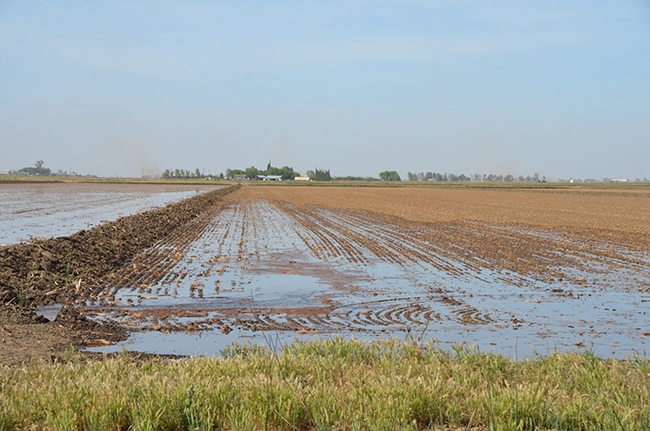
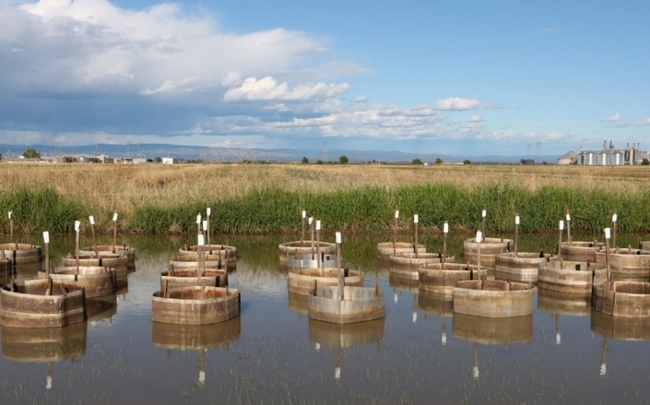

- Author: Kathy Keatley Garvey
Pollination ecologist Alexandra Harmon-Threatt, an associate professor at the University of Illinois, Urbana-Champaign, will speak on "Beyond Flowers; Examining the Role of Soils in Bee Conservation Efforts" at the next UC Davis Department of Entomology and Nematology seminar.
The online seminar, the last of the spring quarter, is set for 4:10 p.m., Wednesday, June 2. Host is pollination ecologist and professor Neal Williams. Access the Zoom link here.
More than 80 percent of bees nest below ground and most univoltine species spend more than 90 percent of their life cycle in contact with soils, Harmon-Threatt points out. "Yet most conservation efforts ignore soils and few research studies consider these critical life stages and possible exposures that occur during them. In a series of studies, our lab has begun to explore how much soils matter and whether ignoring them is to the detriment of conservation."
In her research, Harmon-Threatt zeroes in on understanding the patterns and processes that govern plant-pollinator interactions for conservation. "Pollinators play a vital role in plant reproduction, food production and ecosystem stability but are believed to be declining globally," she says. Her work focuses on identifying and understanding patterns in natural environments to help conserve and restore pollinator diversity. With a particular focus on bees, she investigates how a number of factors at both the local and landscape scale, including plant diversity, isolation and bee characteristics, effect bee diversity in local communities.
Harmon-Threatt received her doctorate from UC Berkeley, where she worked on bumble bee preferences and phylogenetic patterns. She completed a National Science Foundation postdoctoral fellowship in biology at Washington University in St. Louis.
She was recently featured on the podcast, People Behind the Science. Any change in pollinator populations, she told her audience, can have significant effects on natural and agricultural communities. Recent declines in bee populations, in particular, indicate how "little we know about these important insects in their natural environments, she told her audience."
Cooperative Extension specialist Ian Grettenberger, coordinator of the spring seminars, e may be reached at imgrettenberger@ucdavis.edu for any technical issues.
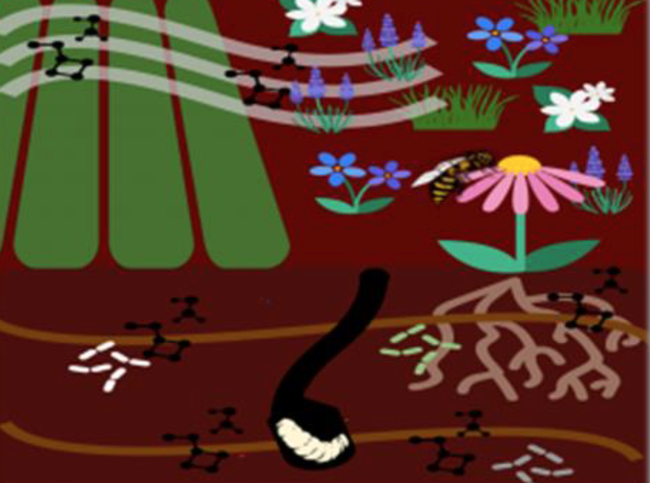
- Author: Kathy Keatley Garvey

All seminars will be held on Wednesdays at 4:10 p.m. (Pacific). Join the Zoom seminars by accessing the links below.
March 31
Bob Peterson
Montana State University, Land Resources and Environmental Sciences
Title: "Tigers in Yellowstone National Park: Insect Adaptations to Extreme Environments"
Host: James R. Carey
See seminar at https://youtu.be/z85B0NlmizU
April 14
Swapna Priya Rajarapu
North Carolina State University, Department of Entomology and Plant Pathology
Title: "Insect-Plant Molecular Interactions: Stories from Invasive Insects to Disease Vectors"
Host: Diane Ullman
Zoom info
April 21
Chris Hamilton
University of Idaho, Department of Entomology, Plant Pathology and Nematology
Title: "Understanding Aphonopelma Diversity Across the Madrean Pine-Oak Woodlands Hotspot by Integrating Western Science and Traditional Ecological Knowledge (TEK)"
Host: Jason Bond
Zoom info
April 28
Ellen Currano
University of Wyoming, Department of Geology and Geophysics
Title: "Ancient Bug-Bitten Leaves Reveal the Impacts of Climate and Plant Nutrients on Insect Herbivores"
Host: Emily Meineke
Zoom info
May 5 CANCELLED, DUE TO UNAVOIDABLE CIRCUMSTANCES
Gabe Zilnik
USDA-ARS Wapato, Wash., Temperate Tree Fruit and Vegetable Research
Title: "Improving Tobacco IPM with Machine Learning"
Host: Madi Hendrick
(Plans call for a future seminar)
May 12
Margarita López-Uribe
Pennsylvania State University, Department of Entomology
Title: "Ecoevolutionary Consequences of Crop Domestication on Plant-Pollinator Interactions"
Host: Rachel Vannette
Zoom info
May 19
Manuela Ramalho
Cornell University
Title: "Exploring Connections Among Microbial Community, Ecology and Phylogenetic History of Ants"
Host: Marshal McMunn
Zoom info
May 26
Javier Ceja Navarro
Lawrence Berkeley National Laboratory, Biological Systems and Engineering
Title: "The Complex Microbial Life and Interactions in Lilliputian Landscapes: from the Guts of Insects to the Rhizophere"
Host: Rachel Vannette
Zoom info
June 2
Alexandra Harmon-Threatt
University of Illinois Urbana-Champaign, Department of Entomology
Title: "Beyond Flowers; Examining the Role of Soils in Bee Conservation Efforts"
Host: Neal Williams
Zoom info
For any questions, email Ian Grettenberger (imgrettenberger@ucdavis.edu).
- Author: Kathy Keatley Garvey
(Editor's Note: See this March 31st seminar on YouTube at https://youtu.be/z85B0NlmizU)
Robert K. D. 'Bob' Peterson, professor of entomology at Montana State University (MSU), Bozeman, and the 2019 president of the Entomological Society of America (ESA), will speak on "Tigers in Yellowstone National Park: Insect Adaptations to Extreme Environments" at the UC Davis Department of Entomology and Nematology's online seminar on Wednesday, March 31.
His seminar, hosted by UC Davis distinguished professor James R. Carey, a fellow of ESA, begins at 4:10 p.m. Access this Google document to attend the Zoom event.
The "tigers" are the tiger beetles that live, feed and breed in the thermal pools.
Peterson, with MSU's Land Resources and Environmental Sciences, leads the research, teaching and outreach program in Agricultural and Biological Risk Assessment, a program centered on comparative risk assessment. His other areas of research include insect ecology, plant-stress ecophysiology, and integrated pest management. Peterson teaches undergraduate and graduate courses, including environmental risk assessment, insect ecology and various special-topics graduate courses. He also directs MSU's professional master's degree program in environmental sciences.
A native of Perry, Iowa, Peterson received his bachelor's degree in entomology from Iowa State University, Ames, and his master's degree and doctorate in entomology from the University of Nebraska, Lincoln. He joined the MSU faculty in 2002 after serving as a research biologist for Dow AgroSciences, Omaha from 1995 to 2001. He has published 123 peer-reviewed journal articles, 15 book chapters, and two books.
Peterson manages the website, Insects of the Greater Yellowstone Ecosystem, an online photographic celebration of the ecosystem's biodiversity. He describes it as a "celebration of the "incredible diversity and abundance of insects in the area." Peterson categorized the site into butterflies and moths; beetles; flies; true bugs; stoneflies; mayflies; net-winged insects; bees, wasps ants and sawflies; grasshoppers, crickets and katydids; and insect relatives. Peterson also hosts a comparable Facebook page, Insects of the Greater Yellowstone Ecosystem.
In addition, Peterson is affiliated with two other websites, Insects, Disease and History, devoted to "understanding the impact that insects, especially insect-borne diseases, have had on world history"; and Ag Biosafety, designed to be a "definitive source of scientific, regulatory and educational materials relevant to crop biotechnology and the current debate on the genetic modification of food."
Cooperative Extension specialist Ian Grettenberger coordinates the spring seminars. For technology problems, contact him at imgrettenberger@ucdavis.edu.


